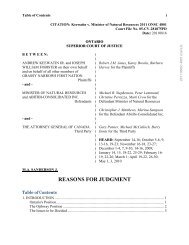Cronk v. Canadian General Insurance Co., 1995 CanLII 814 (ON CA)
Cronk v. Canadian General Insurance Co., 1995 CanLII 814 (ON CA)
Cronk v. Canadian General Insurance Co., 1995 CanLII 814 (ON CA)
You also want an ePaper? Increase the reach of your titles
YUMPU automatically turns print PDFs into web optimized ePapers that Google loves.
equired by the Employment Standards Act . The Supreme <strong>Co</strong>urt, like the Ontario<br />
<strong>Co</strong>urt of Appeal, held that the effect of ss. 3 and 4 of the Act was to make any<br />
attempt to contract out of the minimum employment standards in the Act null and<br />
void. A determination therefore had to be made as how notice was to be assessed.<br />
The approach used by the <strong>Co</strong>urt of Appeal in determining the amount of notice<br />
was to imply a term in the contract stipulating the minimum notice requirement<br />
under the Employment Standards Act . This was based on what the <strong>Co</strong>urt of<br />
Appeal thought could be inferred from the intention of the parties at the time of<br />
hiring in light of the court's interpretation of the Act. The Supreme <strong>Co</strong>urt<br />
unanimously rejected this approach. Iacobucci J., who wrote the majority opinion,<br />
held that the two employees with this term in their contract were entitled to<br />
reasonable notice at common law and used the Bardal approach to determine the<br />
amount of reasonable notice. He did so on the basis that a clause in a contract that<br />
is null and void should be given no effect and should not be used as an indication<br />
of the intention of the parties. In addition, on policy grounds, he felt that the<br />
contract should be interpreted so as to encourage employers to comply with the<br />
Act; implying reasonable notice would give employers more incentive to obey the<br />
law. McLachlin J., however, in a separate concurring judgment, went further than<br />
Iacobucci J. and found contractual intention to be irrelevant to determination of<br />
the notice period. She commented on the factors in Bardal , at p. 1009:<br />
These considerations determine the appropriate notice period on<br />
termination. They do not depend upon contractual intention. Indeed, some<br />
of them — such as the length of service and prospects of employment —<br />
are usually not known at the time the contract is made.<br />
The decision of the trial judge in awarding seven and seven and a half months pay<br />
in lieu of notice to the two employees respectively was unanimously restored by<br />
the court.<br />
In Wiebe v. Central Transport Refrigeration (Manitoba) Ltd. 1994 <strong>CanLII</strong> 6406<br />
(MB C.A.), (1994), 3 C.C.E.L. (2d) 1 (Man. C.A.) , at p. 6. Twaddle J.A. observed<br />
that when the Supreme <strong>Co</strong>urt quoted the Bardal test in Machtinger , supra, that<br />
language was "an endorsement of the Bardal approach and a rejection of the<br />
implied intention approach in deciding what is reasonable."<br />
A more philosophical approach is taken by Patrick Macklem in "Developments in<br />
Employment Law: The 1991-1992 Term," in 4 Sup. Ct. L. Rev. (2d) 279, at pp.<br />
284-288. Professor Macklem views the decision of the <strong>Co</strong>urt of Appeal as a<br />
contractualist approach to reasonable notice, that is, one based on discerning the<br />
intent of the parties at the time of employment, whereas the approach of Iacobucci<br />
J. relies on external justifications for determining reasonable notice. He observes<br />
that, once the court moves beyond the confines of attempting to discern the intent<br />
of the parties at the time of employment, the approach to reasonable notice need<br />
not be status-based. In Machtinger , supra, Iacobucci J. stressed as part of his
















